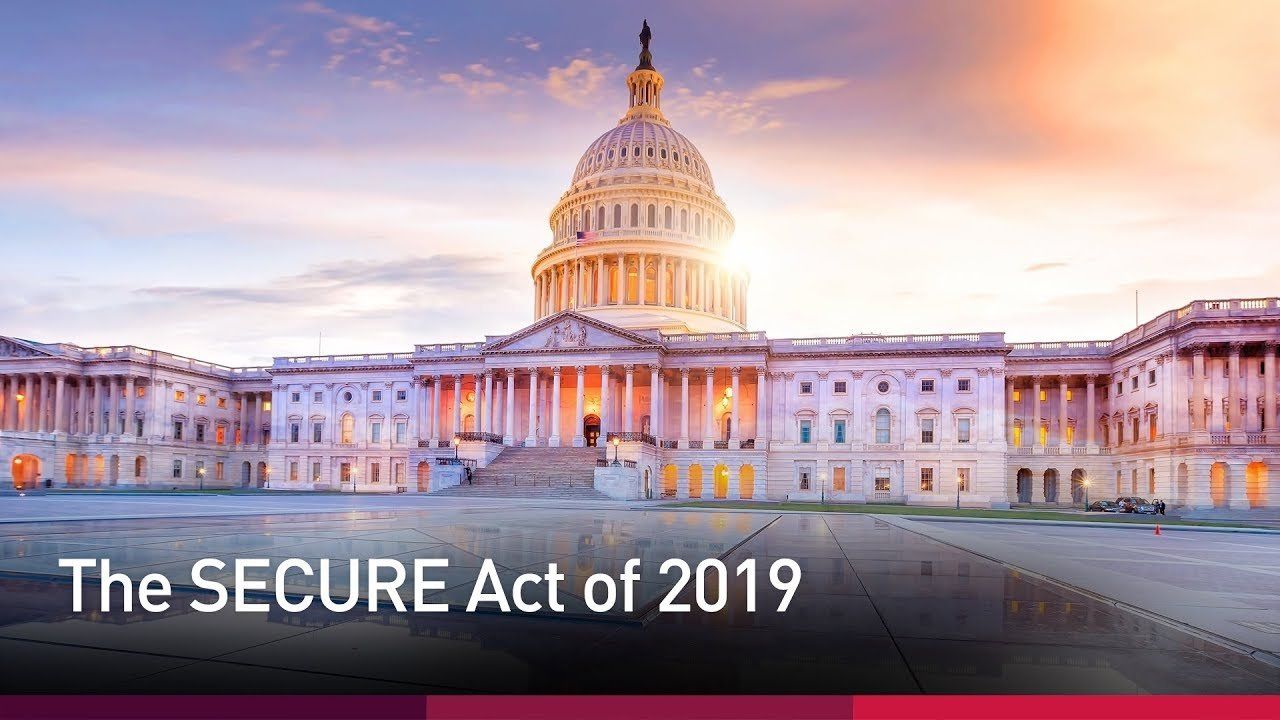Blog Layout
The SECURE Act's Impact on Your Retirement
Eric Sajdak • January 3, 2020
Turn on the news, and you will hear about impeachment hearings, trade wars, and a booming year
in the stock market.
If you blinked, you missed the passing of the “Setting Every Community Up for Retirement Enhancement Act”... Wow, what a mouthful. Otherwise known as the SECURE Act.
The changes laid out in this act are the biggest we’ve seen since the Tax Cuts of 2017.
Here are a few of the significant changes that will impact your retirement:
1. RMDs Begin at 72 Rather Than 70 ½
Tax-Deferred accounts are subject to something called a Required Minimum Distribution (RMD). Basically, an RMD is the government forcing you to money out of accounts like IRAs and 401ks. Before the SECURE Act, these began at 70 ½.
Changes in the SECURE Act push this age back 1.5 years to 72.
This age change has significant planning implications! One of the strategies we use in our practice is forward-looking RMD planning (the time for RMD planning is in your 50’s and 60’s). We often see retirees enter into their 70s and pay very little attention to their RMDs. In most cases, this costs the retiree a significant tax burden!
An additional year and a half to plan for and minimize RMDs offers retirees more options.
2. Elimination of Generational Stretch IRAs
Prior to the SECURE Act, there was an obscure section of estate planning tax laws that allowed a retiree to pass on assets through an inherited IRA. Here is a brief example of the estate planning power an inherited IRA had:
Beth (87) is a widowed retiree. She has a $500,000 IRA that she would like to pass on to her grandchild, James (25) because she does not need it to fund her retirement. Before the SECURE Act, she could use a “Stretch” provision and pass her IRA to James. Rather than having to take the full $500,000 at once and pay significant taxes, the stretch provision allows James to take a smaller amount each year over a longer period of time. This ultimately minimizes taxes and allows the money to stay invested longer.
This “stretch” provision has offered serious advantages to retirees looking to pass money on to the next generation. But just like that, poof, it’s gone.
The "10-Year Stretch Rule" replaces the old "stretch" provision. The IRS will now force heirs to take all distributions from that account within ten years. How costly will this be? In short, very. In the example above, forced distributions will move James’ tax brackets up as much as 3-4 whole tax brackets!
Costing him taxes on both his own earnings, as well as distributions from his inherited IRA.
3. An Annuity Rule for 401ks?
A change that looks good on the surface but will have unintended consequences is the opening of a “lifetime income annuity” provision in 401ks.
Up until this point, almost no 401ks offered an option where a participant could invest in an annuity. With the SECURE Act, this is changing.
In the past, annuities were rarely allowed into 401ks because of liability concerns. What happens if the annuity provider goes under? Who is responsible? In the past, the blowback could fall on the employer’s shoulders. Two new rules change this:
- Limited Liability
- In short, if the plan sponsor “diligently” chooses the annuity provider, they are free from liability. Primarily the liability falls on you, the plan participant.
- No Requirement to Select Lowest Cost
- This is generally a good thing. Cost alone doesn’t determine value. However, I cringe anytime this is included in the financial industry. Why? It opens the door for financial advisors to put high-cost annuities in 401ks. The industry already has an issue with transparency and charging clients too much; this will not help.
I believe this will be the most dangerous change in this act. Annuities can be a great retirement planning strategy given the right situation. However, annuities are extremely complex and rarely understood, even by many financial advisors.
It will be a couple of years until we see them as commonplace in 401ks. I would caution investors to stay clear of these options until they are reviewed alongside a trusted retirement planner.
4. Various Retirement Plan Changes
Below is a summary list of some minor and major changes they made to retirement plans:
- Elimination of Age Contribution Limits
- In the past, after 70 ½, you could no longer contribute to IRAs. The SECURE Act eliminates age limits. Now a retiree can work and contribute to IRAs well past 70 ½
- Self Employed Tax Credit
- Small businesses are now eligible for a tax credit for startup costs related to opening a retirement plan (401k, 403b, SEP, SIMPLE, etc.). Depending on the size of your business, this could be as small as $500 or as large as $10,000+
- Penalty-Free Withdrawal for Birth/Adoption
- For younger couples, SECURE now lets you avoid the 10% early withdrawal penalty and take up to $5,000 out of retirement accounts following the birth or adoption of a child.
- Part-Time Employees Gain Access to Retirement Plans - Right now, most part-time employees are excluded from 401ks and other retirement plans. In the past, a part-time employee would need to work 1,000 hours (approx. 20 hours a week) in a year to qualify. Now part-timers can be eligible if they have worked 500 hours for three consecutive years. However, this change will not take effect until 2024 at the earliest
---------------------------------
The changes laid out in the SECURE Act are broad enough; they will affect every retiree. From RMD and retirement plan changes to the elimination of estate planning strategies (stretch provision). Every retirement plan will be affected but at varying levels.
If the SECURE Act passed and your retirement plan isn’t changing accordingly, we strongly urge you to get a second opinion.
The changes laid out in this article were some of the more sweeping changes. To get a better idea of the changes affecting your situation specifically, click the button below to chat with one of our retirement planners.

By Eric Sajdak, ChFC®
•
July 7, 2020
"If I delay my Social Security benefit, at what age would I breakeven versus simply filing at 62?" We field this type of question frequently from retirees. The Social Security system allows you to file anytime between 62 and age 70. At first glance, filing at 62 seems to make the most sense. After all, there are 12 months in a year and eight years between ages 62 and 70—That's 96 months of monthly paychecks that you wouldn't be getting if you delayed. However, you get penalized for taking your benefit early. Below is a diagram showing the penalties and delayed credits for someone whose Full Retirement Age is 66:

By Tony Hellenbrand
•
June 30, 2020
Lately I’ve been getting asked how I was able to “Call the Bottom” in late March. I want to make something clear: I didn’t. If you go back and look at the article from March 16th or read the email I sent out to subscribers on the 26th, (pure dumb luck), I ran a bad case, a best case, and a base case valuation on the S&P 500. I arrived at a base case valuation of 2,950, and at the time the S&P was hovering around 2,300, so we started recommending clients initiate buying plans. These plans did not mean “This is the bottom” or “Go all in.” Far from it. Many of our clients were buying several days before the precise bottom, and several days and weeks after. Regardless of how clearly I try to make this point (that we simply were buying something the math said was likely cheap) this morning my inbox is chock full of people asking what I think about valuations now. Are we in a bubble? Is the market ahead of the fundamentals? Are we going to double dip? Will the market crash? Will we need a second stimulus? Maybe. I have no idea. Here’s what I know, when you accumulate all of the available earnings estimates and make a conservative estimate of fair value, you end up with a fair value of about 3,060 on the S&P 500. As I type this we sit at 3,080. Regardless of whether the number is 2,950 or 3,060 or 3,080 or 3,150, any way you slice it, we’re at fair value, now. Analyst Earnings Estimates:

By Eric Sajdak
•
May 28, 2020
It is your right as an American to (legally) pay the least amount in taxes that you owe—nothing more, nothing less. But in recent years, Congress has made a concerted effort to shift the IRS code and levy you with taxes you didn't even know you were paying. We call these "Stealth Taxes." These changes are never talked about by your congressman (or woman). They lie deep within the tax code and can potentially cost you significantly unless you learn about how to avoid them. In this article, we cover three of those "Stealth Taxes" and what you can do to minimize or avoid them altogether.
Contact Our Team
By using this website, you understand the information being presented is provided for informational purposes only and agree to our Terms of Use and Privacy Policy. Safeguard Wealth Management relies on information from various sources believed to be reliable, including clients and third parties, but cannot guarantee the accuracy and completeness of that information. Nothing in this communication should be construed as an offer, recommendation, or solicitation to buy or sell any security. Additionally, Safeguard Wealth Management or its affiliates do not provide tax advice and investors are encouraged to consult with their personal tax advisors.
All investing involves risk, including the possible loss of money you invest, and past performance does not guarantee future performance. Historical returns, expected returns, and probability projections are provided for informational and illustrative purposes, and may not reflect actual future performance. Please see our Full Disclosure for important details.
Safeguard Wealth Management is a Registered Investment Advisor with the SEC.



